Greetings friends, science and orchid lovers! Today I bring you an interesting post where we will carry out an area sampling in transects and thus determine how many individuals of the species: (Orchis italica) we found in a suburban area in the parish "Qta do Conde" south of Lisbon, the references indicate that the species, unlike some other Ophrys, is common, meaning its distribution is much wider and we find it in a large part of the Portuguese territory, nonexistent in the North where the climate is unfavorable! I will show you how sensitive the common species are and that despite the reference telling us that "it is very common" it is not actually like that.🌷🥽
Saludos amigos amantes de la ciencias y las orquideas! hoy les traigo un interesante post donde vamos a realizar un muestreo de area en transectas y asi determinar cuantos individuos de la especie: (Orchis italica) encontramos en una zona suburbana en la freguesia "Qta do Conde" al sur de Lisboa, las referencias nos indican que la especie a diferencia de alguna otra Ophrys son comunes osea su distribuicion es mucho mas amplia y la conseguimos en una gran parte del territorio Portugues, inexistente en el Norte donde el clima es desfavorable! yo te demostrare lo sensible que son las especies comunes y que apesar de la referencia expresarnos que "es muy comun" en realidad no es asi.✍🏻🚩👨🏻🏫

Sampling area🧭🥽/Area de muestreo🌍✍🏻

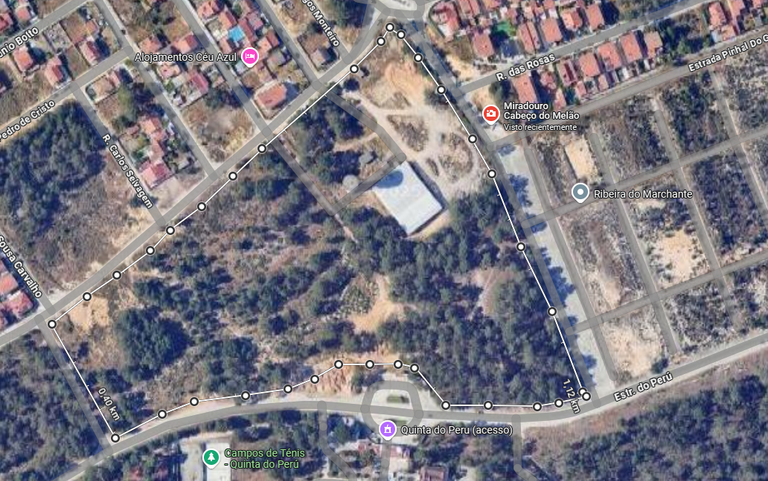
Here I show you the area where I carried out my study, it is a suburban area in "Qta do Conde" municipality of Sesimbra in Portugal, I chose this area because being surrounded by houses I want to measure the impact of people passing through here and who could be a potential risk of "destruction" of the orchids, in total it was 1.2km which gave me: (61,752.21 m²) a fairly acceptable square area, I made straight line transects to cover the area in greater detail, I used "naked eye" for the detection of individuals and my Canon camera. For the distribution map I supported myself with the website: (
https://flora-on.pt/)👨🏻🏫🚩
Aqui te muestro el area donde realice mi estudio, se trata de una zona suburbana en "Qta do Conde" municipio de Sesimbra en Portugal, escogi esta zona porque al estar rodeada de casas quiero medir el impacto que tienen las personas que pasan por aqui y que podrian ser un potencial riesgo de "destruccion" de las orquideas, en total fue 1,2km lo que me dio: (61.752,21 m²) un area cuadrada bastante aceptable, realice transectas en linea recta para cubrir la zona con mayor detenimiento, utilice "ojo desnudo" para la deteccion de individuos y mi camara fotografica Canon. Para el Mapa de distribucion me apoye con la web: (
https://flora-on.pt/)🌷🪻
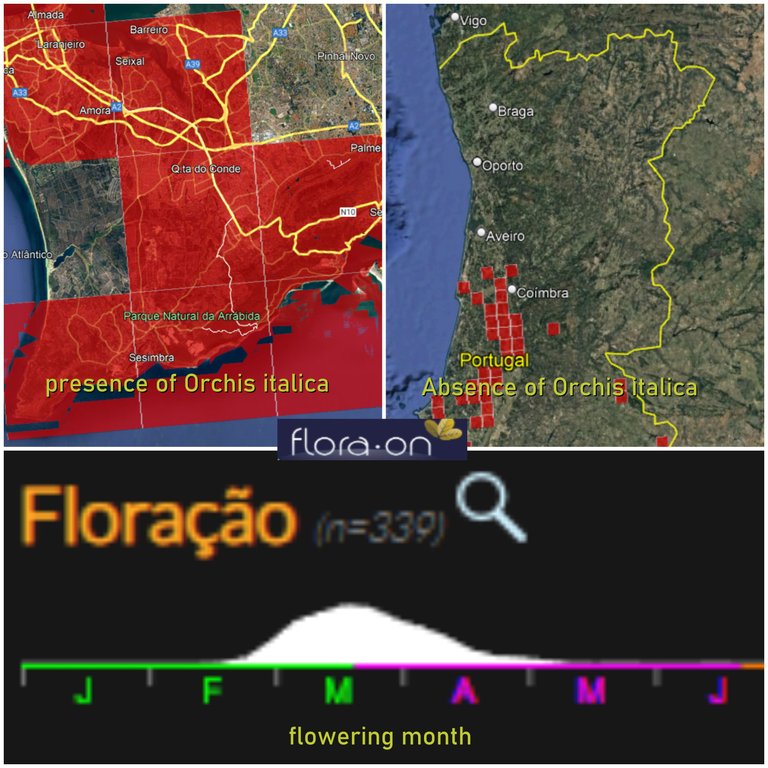
Before going to the field I was doing a series of investigations on the biology of (Orchis italica) clearly we can not go to a place without knowing if we will get our object of study, according to the website: (
https://flora-on.pt/) this species is found in almost the entire territory of the southern margin of Lisbon, with the exception of: (the areas closest to the river and the Atlantic Ocean), it is no coincidence but the sand on these surfaces has different conditions and parameters than in the area I study whose location is less than 5km from the "da arrabida" mountain range, a rock formation with calcareous properties and an alkaline pH, that said, it is time to go to the field to test our acquired theoretical knowledge.✍🏻🥽
Antes de ir al campo estuve haciendo una serie de investigaciones sobre la biologia de (Orchis italica) claramente no podemos ir a un lugar sin saber si conseguiremos nuestro objeto de estudio, segun la web: (
https://flora-on.pt/) esta especie se encuentra en casi todo el territorio del margen sur de Lisboa, a exepcion de: (las areas mas proximas del rio y oceano atlantico), no es coincidencia pero la arena en estas superficies tiene condiciones y parametros diferentes que en el area que estudio cuya localizacion es menos de 5km de la sierra "da arrabida" una formacion rocosa con propiedades calcareas y un pH alcalino, dicho esto es hora de ir al campo a probar nuestro conocimiento teorico adquirido.🌷🚩

Sampling and data collection method🧭🥽/Metodo de muestreo y recoleccion de datos🌍✍🏻
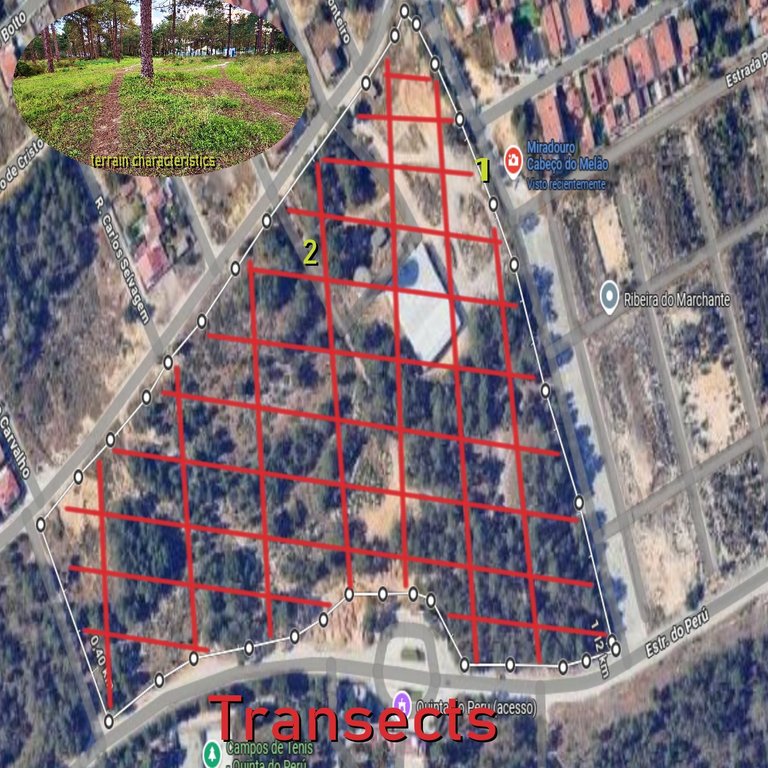
The transect method is one of the most effective forms of data collection that exists, I have used it countless times in my professions, and of course today it would be part of my study, it consists of making imaginary lines in any direction in order to cover an area, there are those who use transects with threads or ropes to not leave any space uninvestigated, I do not have the time or resources for that, that is why my lines are imaginary, and after making the transects I did them from "south to north" so I was able to study the entire area; remember that they are (1.2km), I am in an area with a small forest: (lower sub-humid), (low scrub type), lack of tall trees, presence only of pines.🪻👨🏻🏫
El metodo de transectas es una de las formas de recoleccion de datos mas eficaces que existe, lo use innumerables veces en mis profesiones, y claro hoy seria parte de mi estudio, consiste en hacer lineas imaginarias en cualquier direccion con el fin de abarcar una superficie, hay quienes utilizan las transectas con hilos o cuerdas para no dejar ningun espacio sin investigar, yo no tengo tiempo y recursos para ello por eso mis lineas son imaginarias, y luego de hacer las transectas las hice del "sur al norte" asi consegui estudiar todo el terreno; recordemos que son (1,2km), estoy en un terreno con un pequeno bosque: (sub-humedo inferior), (tipo mato bajo), carencia de arboles altos presencia solo de pinos.🧭🪴🌴🌺
Source:file:///C:/Users/jonat/Downloads/A-Vegetacao-em-Portugal.pdf

Terrain characteristics🧭🥽/Caracteristica del terreno🌍✍🏻

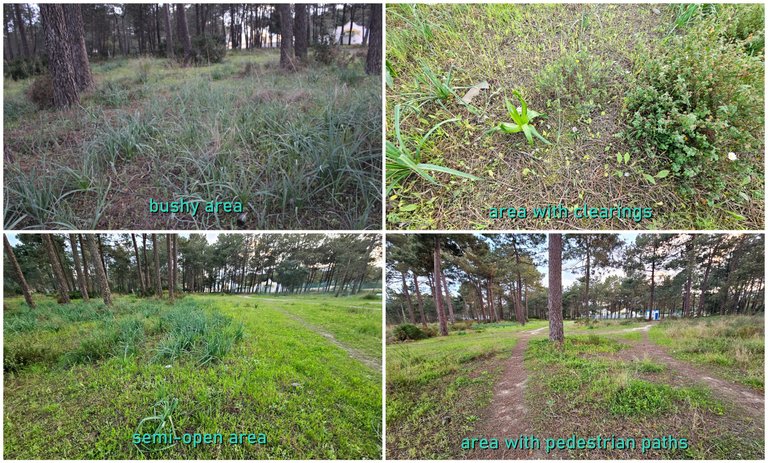
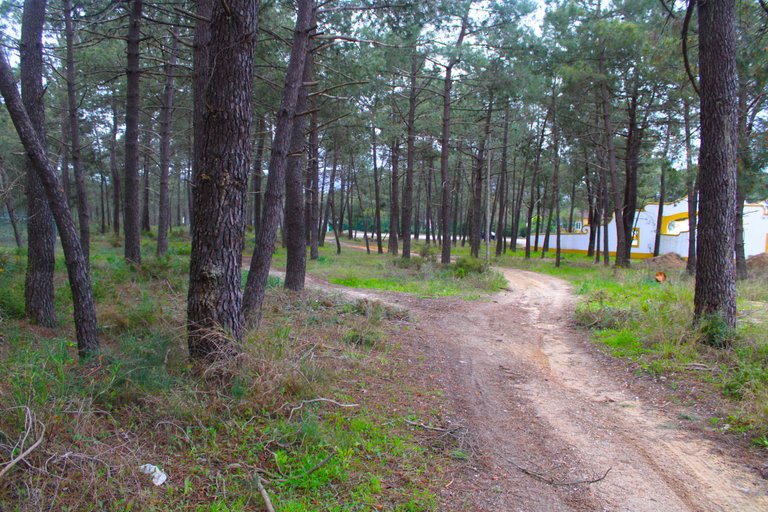
Here you can get an idea of what the studied terrain was like, literally there were areas with more vegetation than others, where the paths were more "marked where people walk" the vegetation is scarce, I suppose that the continuous footsteps do not allow anything to grow, then there are some areas with more pine trees than others and there we can see areas with clearings, and other areas with many more bushes that are difficult to access, the areas where there are many bushes and everything grows to half a meter high were not worth studying because according to the reference (Orchis italica) grows in open areas.✍🏻🥽🌷
Aqui puedes hacerte una idea de como era el terreno estudiado, literalmente tenia zonas con mas vegetacion que otras, donde estaban los caminos mas "marcados por donde las personas circulan", la vegetacion es escasa, supongo que la continua pisadas no permite crecer nada, luego hay unas areas con mas arboles de pino que otras y alli podemos ver zonas con claros, y otras zonas con mucho mas arbustos que son de acceso dificil, las zonas donde hay muchos arbustos y que todo crece a medio metro de altura no valia la pena estudiar porque segun la referencia (Orchis italica) crece en zonas abiertas.🌴🪴🌺
https://almargem.org/biodiv/especie/orchis-italica-por/

Counting specimens🧭🥽/Conteo de ejemplares🌍✍🏻
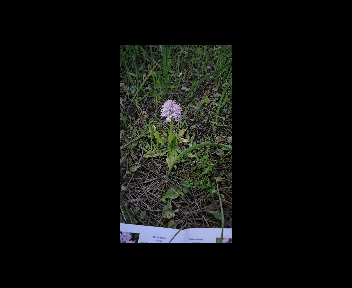
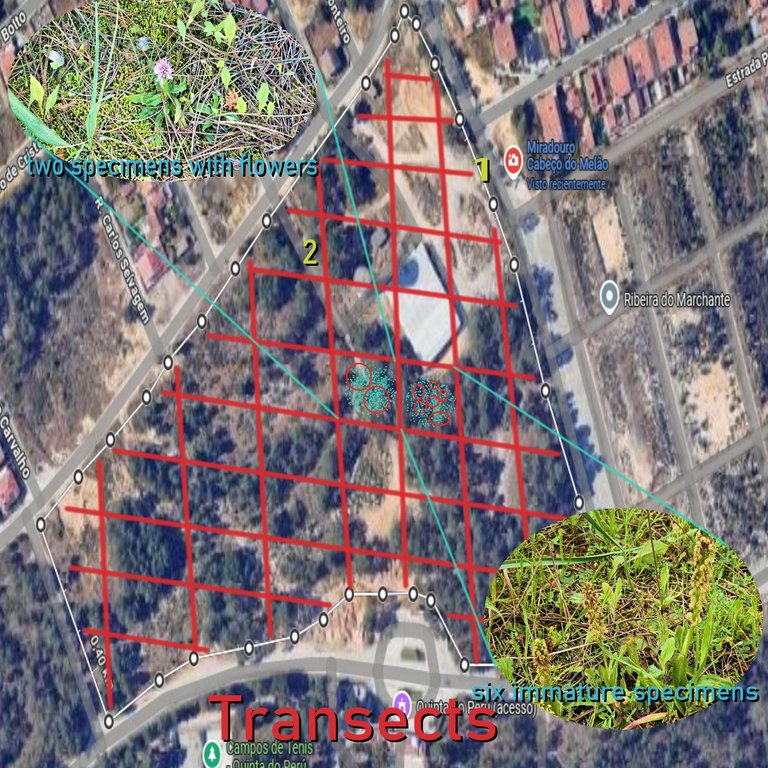
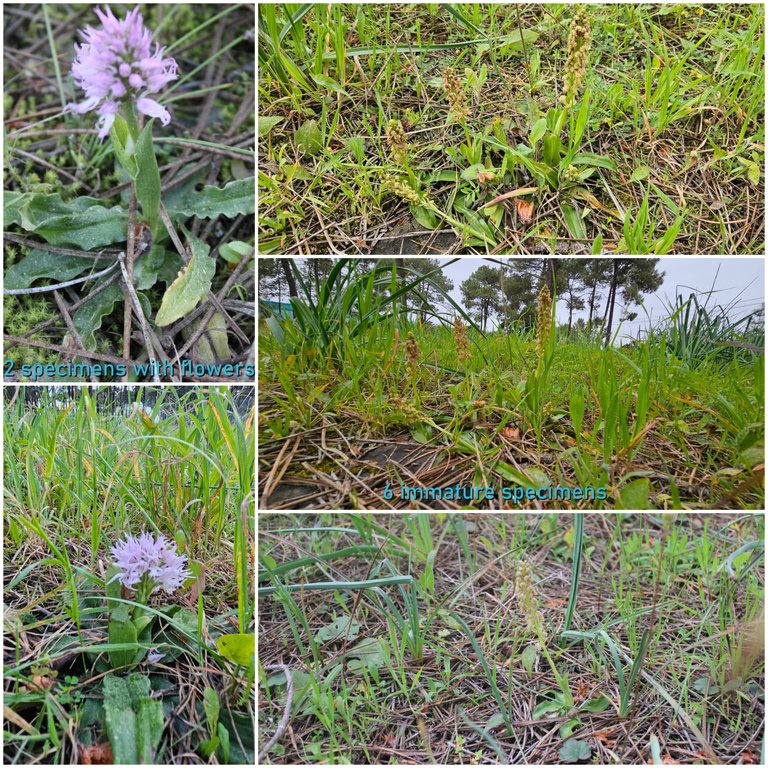
After studying the entire field in as much detail as possible I managed to count a total of 8 specimens of the orchid (Orchis italica) in 1.2km two of which were mature specimens with flowers and the rest (6) immature with just the "buds" growing, I was quite surprised as an orchid that according to the reference: (Britos, 1986) are common in Portugal and I only managed to photograph 8 orchids, while I saw a great variety of plant species in the area, this is a reflection that these plants are delicate and require a very specific parameter to grow, in fact if you look at the map they are all concentrated in the same place. The flowering months go from: (March to June), at the same time I think that the data is not enough to give a conclusion because we are in the month where they begin to flower so perhaps it would be interesting to come back next month and study the area again.🚩🪻👨🏻🏫
Luego de estudiar todo el campo con el mayor detalle posible logre contar en 1,2km un total de 8 ejemplares de la orquidea (Orchis italica) dos de los cuales eran ejemplares maduros con flores y el resto (6) inmaduros con apenas los "botones" en crecimiento, me sorprendio bastante como una orquidea que segun la referencia: (Britos, 1986) son comunes en Portugal y solo logre fotografiar 8 orquideas, mientras vi una gran variedad de especies de plantas en la zona, esto es un reflejo que estas plantas son delicadas y requieren un parametro bastante especifico para crecer, en realidad si observas el mapa todas se centran en un mismo lugar. Los meses de floracion van de: (marzo a junio), al mismo tiempo pienso que los datos no son suficientes para dar una conclusion porque estamos en el mes donde comienzan a florescer por tanto quizas seria interesante venir el proximo mes y estudiar de nuevo la zona.✍🏻✍🏻

Do roads affect orchids?🧭🥽/Los caminos afectan las orquideas?🌍✍🏻

In suburban areas it is very rare to see large animals (predators) capable of stepping on and damaging an orchid, barely rabbits in this area would be the largest mammal, I did not have to investigate much when I was able to determine that in the place where the new specimens grew there were two of them that were stepped on and damaged, with the "stem or flower stick" broken, now imagine that these here grew 5 meters from the paths where people exercise, this already allows me to conclude that all the ones that grow near the path are damaged, and yes! orchids suffer a reduction in their population in suburban areas.🥽👨🏻🏫
En las areas suburbanas es muy extrano ver animales grandes (predadores) capaz de pisar y danar una orquidea, apenas conejos en esta zona seria el mamifero de mayor tamano, no tenia que investigar mucho cuando ya consigo determinar que en el lugar donde crecian los nuevos ejemplares habian dos de ellos que estaban pisados y danados, con el "tallo o vara floral" partida, ahora imaginen que estas de aqui crecieron a 5 metros de los caminos por donde las personas hacen ejercicio, esto ya me permite concluir que todas las que crecen cerca del camino son danadas, y si! las orquideas sufren una reduccion en su poblacion en areas suburbanas.🗺️🌳
Source:file:///C:/Users/jonat/Downloads/A-Vegetacao-em-Portugal.pdf

About: Orchis italica🧭🥽/Sobre: Orchis italica🌍✍🏻

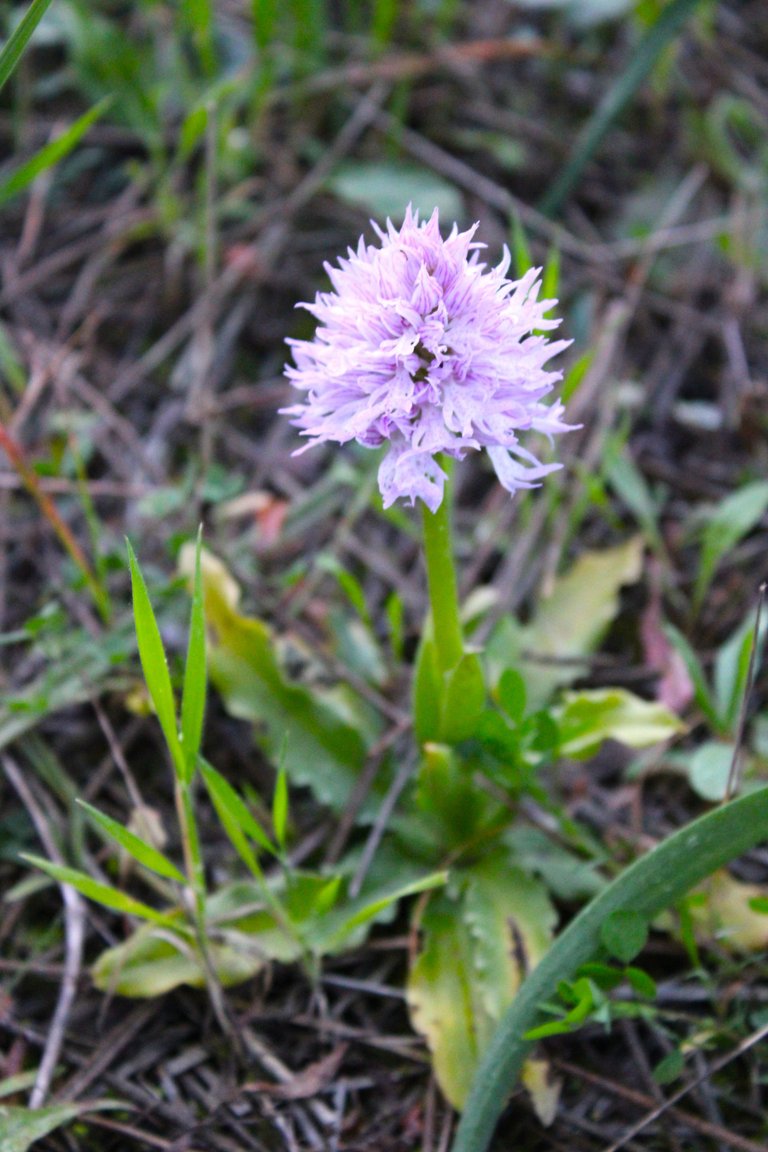
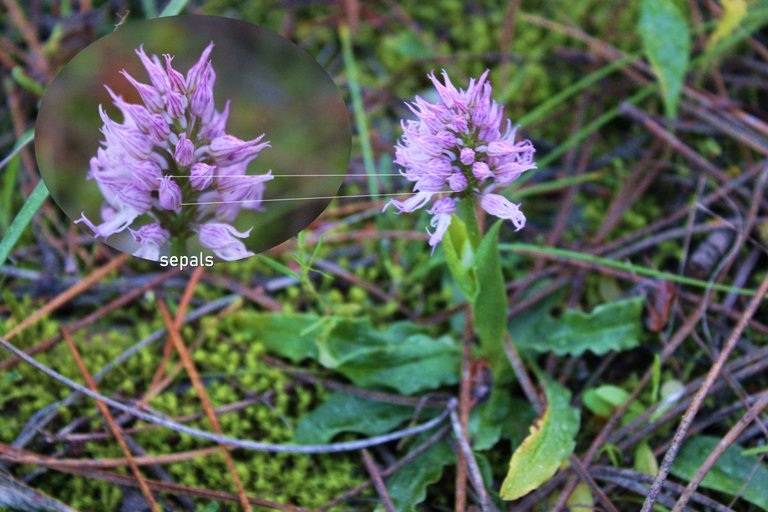
A very common orchid in Portugal, typical of the Mediterranean and preferring humid to slightly dry areas, it does not grow in very humid areas with abundant rainfall and very low temperatures, and is therefore absent in the north of the country. It grows up to 50 cm. It blooms from March to June and can grow in areas with direct or indirect sunlight! My specimens all grew under several pine trees, so they do not receive direct sunlight or direct rain. The soil is very organic, with many layers of pine needles.✍🏻🌴🌷
Orquidea muy comun en Portugal, tipica del mediterraneo y con requerimientos de zonas humedas a poco secas, no crecen en zonas muy humedas y con abundante lluvia y temperaturas muy bajas, y por ello ausentes en el norte del pais, crecen hasta los 50cm. Florecen entre marzo hasta junio, pueden crecer en zonas con sol directo o indirecto! mis ejemplares todos crecieron debajo de varios pinos por eso no reciben sol directo, tampoco lluvia directa, y el terreno muy organico con muchas capas de hojas de pino.🥽🪻

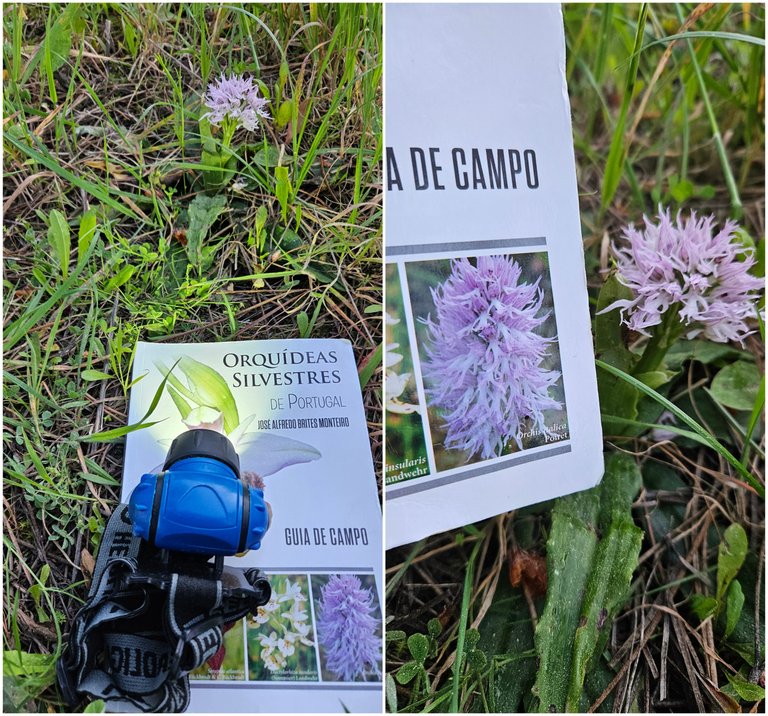
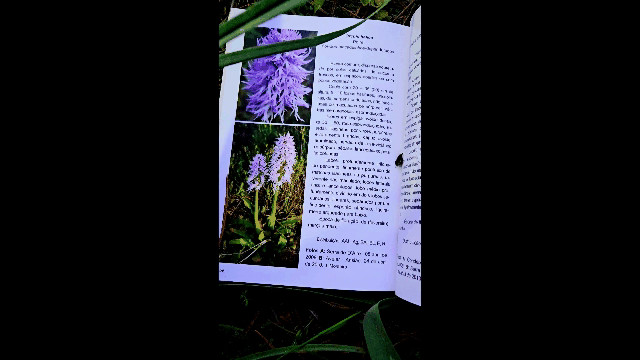
Other important scientific data is the temperature tolerance of the species: (7-13) less than 7 degrees the orchid presents stress, as well as more than 14 degrees, however the time where it has the most energy expenditure is when it flowers, it does so in April, a very cool month with rain in Portugal, this species is not normally found at more than 305 meters high, it prefers soils: (poor in low nutrients, xerophytic, calcareous or siliceous).🌷🌴✍🏻
Otros datos cientificos importantes es la tolerancia de temperatura de la especie: (7-13) menos de 7grados la orquidea presenta estres, al igual que mas de 14grados, sin embargo la epoca donde mas desgaste energetico tiene que es cuando florece lo hace en abril un mes muy fresco y con lluvias en Portugal, esta especie normalmente no la encontramos a mas de 305 metros de altura, prefiere suelos: (pobres en nutrientes bajos, xerofitico, calcaros o silicicos).🗺️👨🏻🏫🚩🌺
https://flora-on.pt/#1orchis+italica

Immature specimen🧭🥽/Ejemplar inmaduro🌍✍🏻
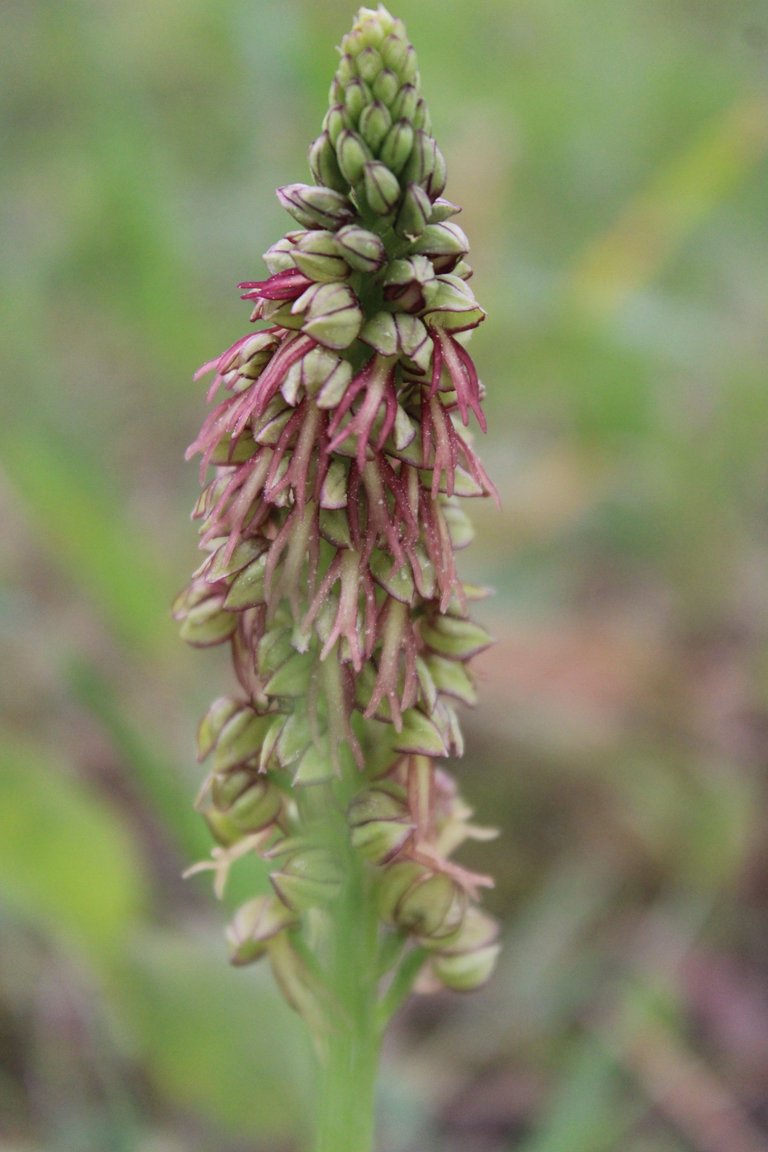
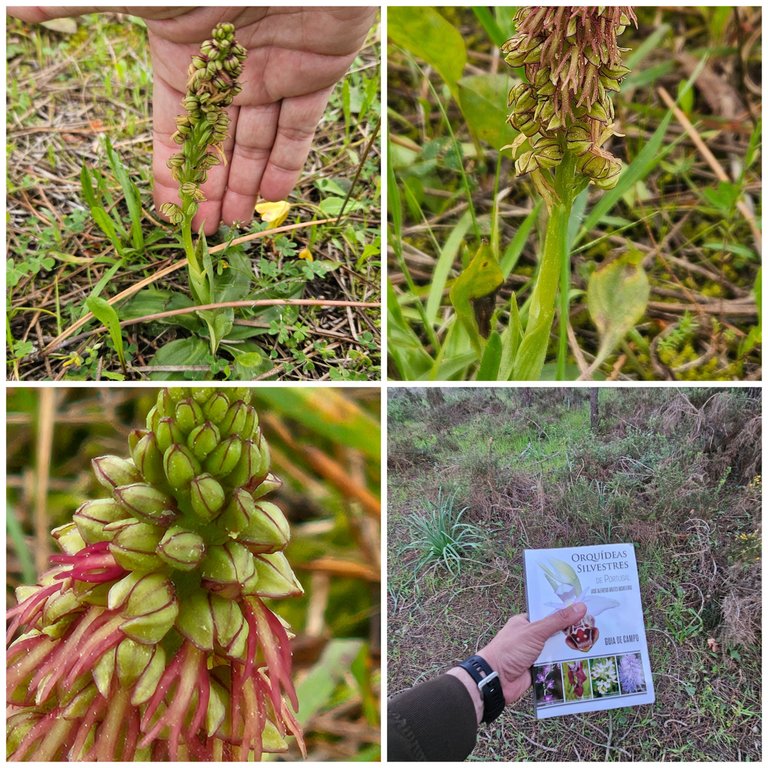
This is a beautiful example of what Orchis italica looks like when it does not yet have flowers or its immature phase, this species is (Geophyte) meaning the part that is above the ground dies at one time of the year while the part below the ground that normally has a bulb survives all year using reserves, where we see Thymelaea broteria it is likely that we get this species since both have similar requirements in terms of soil nutrients.🗺️✍🏻
Este es un hermoso ejemplo de como luce Orchis italica cuando aun no tiene flores o su fase inmadura, esta especie es (Geófito) osea la parte que esta sobre el suelo muere en una epoca del ano mientras que la parte debajo de la tierra que normalmente tiene un bulbo sobrevive todo el ano usando reservas, donde vemos Thymelaea broteria es probable que consigamos esta especie ya que ambos tiene requerimientos similares en cuanto a nutrientes del suelo.🌷🪻🥽
https://almargem.org/biodiv/especie/orchis-italica-por/

Contribution of my research🧭🥽/Aporte de mi investigacion🌍✍🏻
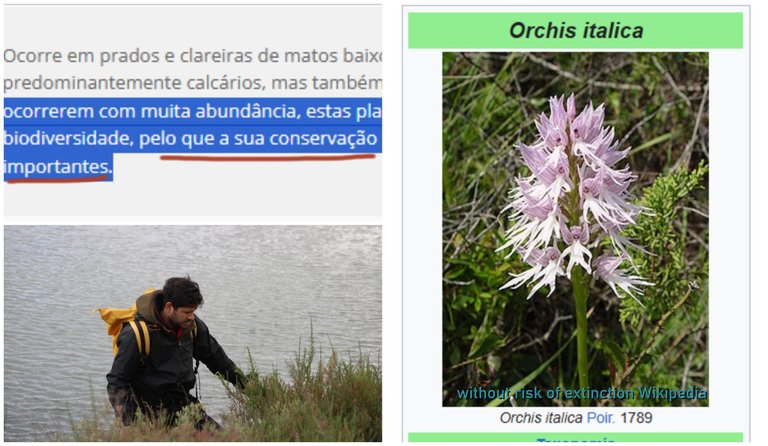
Based on everything I've learned today, I can conclude that the Orchis italica species is sensitive, despite being common in Portugal and quite delicate. That's why the destruction of the land and reduction of its population has led several biologists to classify it as an endangered species and call for its environmental protection. Today, my work has proven that, in more than 61,752.21 m² of land ideal for its growth, seeing only 8 specimens is worrying.🔬🧬⚗️
en base a todo lo aprendido hoy! puedo concluir que la especie Orchis italica es sensible apesar de ser comun en Portugal y bastante delicada, por eso la destruccion del terreno y reduccion de su poblacion a hecho que varios biologos la coloquen como una especie en riesgo y piden su proteccion ambiental, hoy probamos con mi trabajo que en mas de 61.752,21 m² en un terreno ideal para su crecimiento solo ver 8 ejemplares es algo preocupante.💻📕
https://almargem.org/biodiv/especie/orchis-italica-por/


DNA is an organization to foster and DENSIFY NATURE-APPRECIATION which aims to establish REPORTS OF BIODIVERSITY DATA that is contributed by all of us Hiveans and subsequently cataloged.
Therefore DNA searches for HIGH-QUALITY posts that aim to DESCRIBE and determine the BIODIVERSITY AROUND YOU with added EXPLANATIONS and INFORMATION. For these informative posts they offer a CURATION SERVICE using the @dna.org account. It is also a CURATION TRAIL. Just add the #dna TAG if you think that any of your posts is what they are looking for.
THANKS FOR READING ME (PHOTOS AND VIDEOS OF MY PROPERTY) / GRACIAS POR LEERME FOTOS Y VIDEOS DE MI PROPIEDAD🙂🧠🦾👍

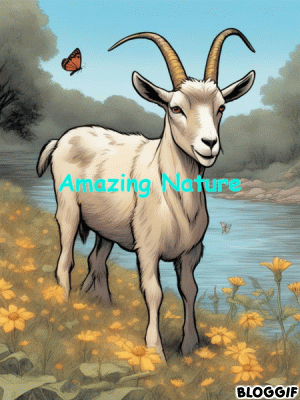
































¡Enhorabuena!
✅ Has hecho un buen trabajo, por lo cual tu publicación ha sido valorada y ha recibido el apoyo de parte de CHESS BROTHERS ♔ 💪
♟ Te invitamos a usar nuestra etiqueta #chessbrothers y a que aprendas más sobre nosotros.
♟♟ También puedes contactarnos en nuestro servidor de Discord y promocionar allí tus publicaciones.
♟♟♟ Considera unirte a nuestro trail de curación para que trabajemos en equipo y recibas recompensas automáticamente.
♞♟ Echa un vistazo a nuestra cuenta @chessbrotherspro para que te informes sobre el proceso de curación llevado a diario por nuestro equipo.
🥇 Si quieres obtener ganancias con tu delegacion de HP y apoyar a nuestro proyecto, te invitamos a unirte al plan Master Investor. Aquí puedes aprender cómo hacerlo.
Cordialmente
El equipo de CHESS BROTHERS
Awesome post!!
Thank you! Your support motivates me because I know someone reads the work, and keep in mind that books sometimes tell us information that isn't reflected in the present, and this "common" species is difficult to see.🤗
Indeed, it is great that you share this important work on the Hive chain and not send it only to an academic journal where noboby sees it (OK, not too many here are reading either 😃). Keep up the good work!
Thanks for your contribution to the STEMsocial community. Feel free to join us on discord to get to know the rest of us!
Please consider delegating to the @stemsocial account (85% of the curation rewards are returned).
You may also include @stemsocial as a beneficiary of the rewards of this post to get a stronger support.
You’ve Been Upvoted By Hive-113748 ~ The Orchid Lovers Community!
We LOVED your post featuring Orchids and are thrilled that you chose our community to share it in!
Thank you :-)
The Orchid Lovers Community
A place for people who Love Orchids!
Your exploration of Orchis italica offers valuable insights into this fascinating species.. It's a shame that humans are forcing them out and possibly onto an endangered list. Sharing such discoveries enhances our appreciation and understanding of the diverse flora in the Mediterranean region, and also helps with preserving them!